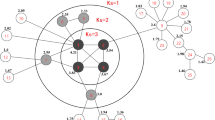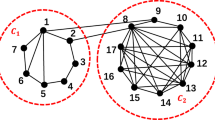Abstract
How to identify influential nodes is still an open hot issue in complex networks. Lots of methods (e.g., degree centrality, betweenness centrality or K-shell) are based on the topology of a network. These methods work well in scale-free networks. In order to design a universal method suitable for networks with different topologies, this paper proposes a Multiple Attribute Fusion (MAF) method through combining topological attributes and diffused attributes of a node together. Two fusion strategies have been proposed in this paper. One is based on the attribute union (FU), and the other is based on the attribute ranking (FR). Simulation results in the Susceptible-Infected (SI) model show that our proposed method gains more information propagation efficiency in different types of networks.
Access this chapter
Tax calculation will be finalised at checkout
Purchases are for personal use only
Preview
Unable to display preview. Download preview PDF.
Similar content being viewed by others
References
Szolnoki, A., Xie, N.G., Ye, Y., Perc, M.: Evolution of emotions on networks leads to the evolution of cooperation in social dilemmas. Physical Review E 87, 042805 (2013)
Newman, M.E.J.: The structure and function of complex networks. Society for Industrial and Applied Mathematics 45(2), 167–256 (2003)
Yan, G., Zhou, T., Wang, J., Fu, Z.Q., Wang, B.H.: Epidemic spread in weighted scale-free networks. Chinese Physics Letters 22(2), 510–513 (2005)
Chen, D.B., Lv, L.Y., Shang, M.S., Zhang, Y.C., Zhou, T.: Identifying influential nodes in complex networks. Physica A: Statistical Mechanics and its Applications 391(4), 1777–1787 (2012)
Albert, R., Albert, I., L.Nakarado, G.: Structural vulnerability of the north american power grid. Physical Review E 69(2), 025103 (2004)
Wuellner, R.D., Roy, S., DSouza, R.M.: Resilience and rewiring of the passenger airline networks in the United States. Physical Review E 82(5), 056101 (2010)
Albert, R., Jeong, H., Barabasi, A.L.: Error and attack tolerance of complex networks. Nature 406(6794), 378–382 (2000)
Hou, B., Yao, Y.P., Liao, D.S.: Identifying all-around nodes for spreading dynamics in complex networks. Physica A: Statistical Mechanics and its Applications 391(15), 4012–4017 (2012)
Liu, J.G., Ren, Z.M., Guo, Q., Wang, B.H.: Node importance ranking of complex networks. Acta Physica Sinica 62(17), 178901 (2013)
Liu, J.G., Wu, Z.X., Wang, F.: Opinion spreading and consensus formation on square lattice. International Journal of Modern Physics C 18(07), 1087 (2007)
Bond, R.M., Fariss, C.J., Jones, J.J., Kramer, A.D., Marlow, C., Settle, J.J., Fowler, J.H.: A 61-million-person experiment in social influence and political mobilization. Nature 489(7415), 295–298 (2012)
Gao, C., Lan, X., Zhang, X.G., Deng, Y.: A bio-inspired mehtodology of identifying influential nodes in complex networks. PLoS ONE 8(6), e66732 (2013)
Yu, H., Liu, Z., Li, Y.J.: Key nodes in complex networks identified by multi-attribute decision-making method. Acta Physica Sinica 62(2), 20204–20204 (2013)
Gao, C., Wei, D.J., Hu, Y., Mahadevan, S., Deng, Y.: A modified evidential methodology of identifying influential nodes in weighted networks. Physica A: Statistical Mechanics and its Applications 392(21), 5490–5500 (2013)
Kitsak, M., Gallos, L.K., Havlin, S., Liljeros, F., Muchnik, L., Stanley, H.E., Makse, H.A.: Identification of influential spreaders in complex networks. Nature Physics 6(11), 888–893 (2010)
Chen, D.B., Gao, H., Lv, L.Y., Zhou, T.: Identifying influential nodes in large-scale directed networks: The Role of Clustering. PLoS ONE 8(10), e77455 (2013)
Barthlemy, M.: Betweenness centrality in large complex networks. The European Physical Journal B-Condensed Matter and Complex Systems 38(2), 163–168 (2004)
Tan, Y.J., Wu, J., Deng, H.Z.: Evaluation method for node importance based on node contraction in complex networks. Systems Engineering-Theory & Practice 26(11), 79–83 (2007)
Zhou, X., Zhang, F.M., Li, K.W., Hui, X.B., Wu, H.S.: Finding vital node by node importance evaluation matrix in complex networks. Acta Physica Sinica 61(5), 050201 (2012)
Page, L., Brin, S., Motwani, R., Winograd, T.: The PageRank citation ranking: bringing order to the web. Technical Report Stanford InfoLab 66 (1999)
Brin, S., Page, L.: The anatomy of a large-scale hypertextual web search engine. Computer Newtworks and ISDN Systems 30(1), 107–117 (1998)
Lv, L.Y., Zhang, Y.C., Yeung, C.H., Zhou, T.: Leaders in social networks, the delicious case. PLoS ONE 6(6), e21202 (2011)
Kleinberg, J.M.: Authoritative sources in a hyperlinked environment. Journal of the ACM 46(5), 604–632 (1999)
Zhang, K., Li, P.P., Zhu, B.P., Hu, M.Y.: Evaluation method for nod importance in directed-weighted complex networks based on PageRank. Journal of Nanjing University of Aeronautics and Astronautics 45(3), 429–434 (2013)
Bu, T., Towsley, D.: On distinguishing between internet power law topology generators. In: Proceedings of the Twenty-First Annual Joint Conference of the IEEE Computer and Communications Societies (INFOCOM 2002), vol. 2, pp. 638–647 (2002)
Gao, C., Liu, J.N., Zhong, N.: Network immunization and virus propagation in email networks: experimental evaluation and analysis. Knowledge and Information Systems 27(2), 253–279 (2011)
Garas, A., Argyrakis, P., Rozenblat, C., Tomassini, M., Havli, S.: Worldwide spreading of economic crisis. New Journal of Physics 12(11), 113043 (2010)
Author information
Authors and Affiliations
Editor information
Editors and Affiliations
Rights and permissions
Copyright information
© 2014 Springer International Publishing Switzerland
About this paper
Cite this paper
Zhong, L., Gao, C., Zhang, Z., Shi, N., Huang, J. (2014). Identifying Influential Nodes in Complex Networks: A Multiple Attributes Fusion Method. In: Ślȩzak, D., Schaefer, G., Vuong, S.T., Kim, YS. (eds) Active Media Technology. AMT 2014. Lecture Notes in Computer Science, vol 8610. Springer, Cham. https://doi.org/10.1007/978-3-319-09912-5_2
Download citation
DOI: https://doi.org/10.1007/978-3-319-09912-5_2
Publisher Name: Springer, Cham
Print ISBN: 978-3-319-09911-8
Online ISBN: 978-3-319-09912-5
eBook Packages: Computer ScienceComputer Science (R0)




